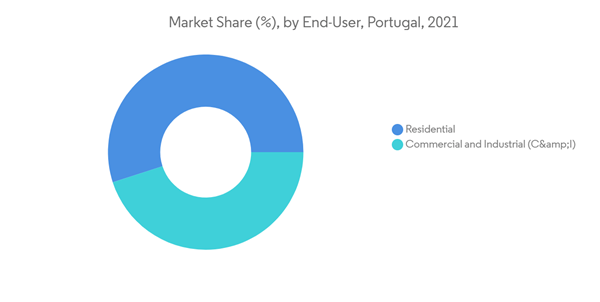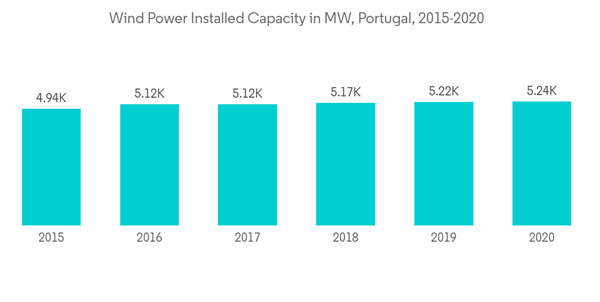The Portuguese solar energy market is expected to record a CAGR of more than 6.5% during the forecast period (2022-2027). The COVID-19 outbreak notably impacted the GDP, which declined by 8.4% in 2020, the largest annual decline since 1936. In March 2020, Portugal announced a EUR 9.2 billion stimulus package. Portugal's government also took actions specific to the energy sector, including fast-tracking the permitting and grid connection of 220 solar photovoltaic (PV) projects. The primary drivers of the market include rising energy demand, efforts to reduce the reliance on fossil fuel-based power generation, and the declining cost of solar PV and associated systems. Other factors such as rising investments in solar farms and supportive government policies are also likely to drive the solar energy market in Portugal during the forecast period. However, the increasing adoption of alternate clean energy sources like the wind is likely to restrain the market's growth during the forecast period.
Portugal’s solar energy market is moderately consolidated. The key players in the market include Voltalia SA, Iberdrola SA, SGS SA, Acciona SA, and Gesto Energia SA.
This product will be delivered within 2 business days.
Key Highlights
- The residential segment is expected to witness significant growth in the market during the forecast period.
- The termination of two coal-fired power plants in Portugal in 2021 provided investment opportunities for solar energy operators. The shift toward adopting renewable energy, especially solar energy, is expected to create immense opportunities for the market.
- Increasing demand for wind energy is expected to restrain the growth of Portugal’s solar energy market during the forecast period.
Key Market Trends
Residential Segment to Witness Significant Growth
- Solar power is a growing source of clean energy in the Portuguese energy mix. At the end of 2020, solar power had a total installed capacity of 1025 MW. It represented more than 3% of total power generation in 2020. The share of renewable electricity reached 60.8% in relative terms compared to total national electricity generation.
- Solar is expected to play a leading role in the Portuguese government’s new energy plan, which includes providing 80% of the country’s power demand from renewables by 2030 and 100% by 2050, and electrifying 65% of the economy by 2050.
- The increasing adoption of solar photovoltaics in the residential sector is primarily driven by expected savings in electricity costs, the need for an alternative source of electricity, and the desire to mitigate climate change risk.
- In December 2021, the Minister of Environmental and Climate Action of Portugal announced the launch of an auction for 262 MW floating solar photovoltaic (PV) capacity to be installed at seven dams across the country. The project is expected to be fully operational by 2023.
- During the forecast period, the share of rooftop solar PV is expected to increase due to decreasing solar PV costs, supportive government policies for residential solar PV, FIT programs and incentives, and targets set by various governments for solar energy.
- The cost reductions from residential rooftop solar PV are driven by continuous technological improvements, including higher solar PV module efficiencies, which may boost solar energy usage in the residential sector for power utilization.
- Therefore, such factors may drive the demand for residential solar energy in Portugal during the forecast period.
Increasing Demand for Wind Energy Restraining the Market’s Growth
- Portugal's renewable energy mix is dominated by solar and hydropower power. However, this scenario has changed with the wind energy sector’s rapid growth.
- Renewables accounted for 69.9% of the country's total electricity demand, and wind energy accounted for 25% at the beginning of 2020.
- The wind energy sector achieved a maturity status within the Portuguese power system. In 2020, the overall 1,592 TWh of electricity was generated from wind installations, 12% more than in 2019.
- At the end of 2020, Portugal's wind power installed capacity was 5,239 MW. In 2020, wind power represented 27.9% of total electricity generation. Thus, Portugal’s wind energy sector is likely to hinder the market.
- In January 2021, the European Investment Bank (EIB) provided EUR 65 million and an additional EUR 47 million from BPI to finance the EDP Renovaveis SA (EDPR) for the construction and operation of two onshore wind farms with a total nominal capacity of 125 MW in the districts of Coimbra and Guarda, Portugal.
- Therefore, the wind energy sector in the country grew faster than the solar energy sector during the last decade. However, it is expected to restrain the market during the forecast period.
Competitive Landscape
Portugal’s solar energy market is moderately consolidated. The key players in the market include Voltalia SA, Iberdrola SA, SGS SA, Acciona SA, and Gesto Energia SA.
Additional Benefits:
- The market estimate (ME) sheet in Excel format
- 3 months of analyst support
This product will be delivered within 2 business days.
Table of Contents
1 INTRODUCTION
4 MARKET OVERVIEW
5 MARKET SEGMENTATION - BY END USER
6 COMPETITIVE LANDSCAPE











